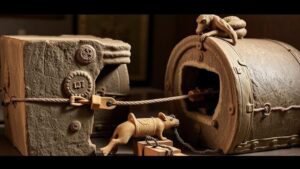Detecting for Stashes of Hidden Money in Deserted Jailhouses
Detecting for Stashes of Hidden Money in Deserted Jailhouses
The intrigue surrounding deserted jailhouses often stems from their storied pasts and the mysteries they hold. One of the less-discussed aspects of these abandoned structures is the potential for hidden stashes of money. This article explores the methods and technologies employed in detecting these hidden resources, as well as notable case studies that highlight their efficacy.
The Historical Context of Hidden Money in Jailhouses
Throughout history, individuals incarcerated in prisons have resorted to hiding money to either protect their assets or plan for life after their release. Often, inmates could not trust their environment or fellow prisoners. Jailhouses have seen numerous creative hiding spots, including inside walls, beneath floors, or even within plumbing systems.
For example, during the 1970s, an inmate at San Quentin State Prison notoriously buried a large sum of cash beneath a deteriorating floor panel, which went unnoticed during several inspections. Such stories enhance the allure of abandoned jailhouses, making them focal points for treasure hunters and researchers alike.
Techniques for Detection
Detecting hidden money in deserted jailhouses can be approached using a variety of methods, often crossing into disciplines such as archaeology, forensic science, and modern technology.
Ground Penetrating Radar (GPR)
Ground Penetrating Radar is a powerful tool utilized in detecting anomalies beneath the surface. By emitting high-frequency radio waves into the ground, GPR can identify irregularities such as cavities, voids, or even buried objects.
Urban archaeologists have successfully employed GPR in sites like the infamously abandoned Eastern State Penitentiary in Philadelphia. In 2021, a GPR survey revealed anomalies that were later excavated, uncovering hidden compartments used by inmates to store contraband.
Metal Detectors
Metal detectors remain a staple in the exploration of hidden assets. Since many stashes of money may be held in metal containers or wrapped with metallic barriers, employing a metal detector can significantly increase the chances of discovery.
For example, a group of treasure hunters in 2019 utilized metal detectors at the now-closed Alcatraz Federal Penitentiary and found several rusted cans filled with coins and jewelry hidden beneath a stairwell, believed to belong to inmates who had attempted to escape.
Drone Technology
Drones equipped with thermal imaging cameras can aid in the detection of anomalies that would be imperceptible to the naked eye. heat signatures of buried caches can stand out against the cooler ground surrounding them, making thermal drones a valuable asset.
In 2022, a team of engineers developed a thermal drone system that successfully identified a hidden storage area in a remote jailhouse in the Midwest. Subsequent excavation revealed several packages of cash that had been buried during the facilitys operational years.
Challenges in Detection
While various techniques offer promise, several challenges arise in the search for hidden money in abandoned jailhouses.
- Structural Instability: Many deserted jailhouses are in a state of disrepair, making exploration hazardous.
- Legal Permissions: Obtaining permission to excavate or use detection equipment often involves navigating complex legal issues.
- False Positives: Techniques such as GPR or metal detection may yield false readings, complicating the search process.
Case Studies Highlighting Success
Several instances demonstrate successful detection and retrieval of hidden money in abandoned jailhouses, providing insights into effective methodologies.
The Alcatraz Coin Discovery
In 2019, treasure hunters using a combination of metal detectors and ground excavation in the notorious Alcatraz Federal Penitentiary led them to an unexpected cache of coins buried near the prison’s exercise yard. The success of this expedition emphasized the value of collaboration between amateurs and historians, as the insights acquired contributed to a deeper understanding of inmate life during Alcatrazs operational years.
Eastern State Penitentiary Excavation
In another notable example, a project aimed at historical preservation utilized GPR at Eastern State Penitentiary. findings facilitated a nuanced study into inmate behavior and contraband smuggling, ultimately fostering greater awareness about the prison reform movement.
Actionable Takeaways
- Understanding the historical context of hidden money can enrich detection efforts and guide search strategies.
- Utilizing modern technology such as GPR, metal detectors, and drones can improve success rates in finding hidden assets.
- Anticipating challenges, including legal hurdles and potential structural hazards, is crucial for safe and effective exploration.
Detecting hidden money in deserted jailhouses is not only about financial discovery; it also serves as a window into the past, shedding light on human behavior, ingenuity, and the complexities of incarceration. As technology advances and archaeological methods evolve, treasure seekers and researchers will continue to explore the depths of these storied locations for hidden treasures long forgotten.



